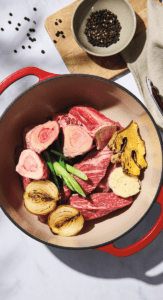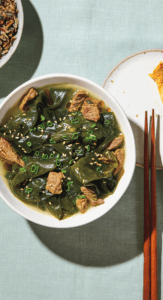
These traditional Asian recipes from Sophia Nguyen Eng, brimming with wholesome ingredients, are perfect for all the family
For thousands of years, many Asian cultures have believed that the secret to health and healing lies in balancing the body’s internal systems. This belief is reflected in Traditional Chinese Medicine (TCM), which views the body as a holistic entity and makes no clear distinction between food and medicine.
In fact, yi chi tong yuan is a Chinese saying that states that food and medicine are from the same source. This perspective has led to a deep respect for the healing properties of food, which is woven into the fabric of everyday Asian cuisine.
While some medicinal herbs and ingredients are particularly potent and are used only for severe illnesses, many are as common in Asian cooking as ketchup and mustard are in America.
Most traditional Asian recipes use a wide array of herbs, spices and other seasonings, such as ginger, garlic, scallions (spring onions), star anise and cinnamon, that have been shown to have a variety of health benefits. For example, ginger is used to aid digestion and relieve nausea, while garlic has antimicrobial and immune-boosting properties.
In the West, there has been a recent resurgence of interest in reviving traditional foods and preparation techniques. This has led to a blending of East and West—many Western recipes incorporate traditional Asian ingredients and cooking techniques. They also share an emphasis on seasonal and locally sourced foods.
The body’s needs change throughout the year, and consuming foods that are in season and grown locally can provide the nutrients and energy needed to support optimal health.
Here’s a selection of some of my favorite traditional recipes for health and healing.

I love bone marrow, and I love it even more when I can put it in a pot of beef broth to enhance its flavor and texture. After a long simmer, the marrow renders and the tendons soften.
A nutritional powerhouse, bone marrow is a good source of healthy fats, vitamins and minerals. Once the broth is done, I like to scrape the marrow out of the bones and spread it on toast, topped with pickled onions.
Makes 2 gallons (7.5 L)
Ingredients
4 to 6 (2-in. or 5-cm) grass-fed beef marrow bones and knucklebones
1 lb (450 g) boneless grass-fed beef chuck or other beef cut, cut into large pieces
2 Tbsp (30 mL) apple cider vinegar
1 onion, halved
1 (5-oz or 140-g) piece fresh ginger, tenderized (see below)
2 gal (7.5 L) spring water, plus more if needed
1 head garlic, outer papery skin removed, cut in half crosswise
3 scallions, cut into 2-in. (5-cm) pieces
1 Tbsp white peppercorns, toasted
1 Tbsp black peppercorns, toasted
Method

My mother introduced me to fermented black garlic, which I especially love because it tastes more like candy than it does the pungent flavor of raw garlic. When fermented, garlic undergoes a chemical reaction known as the Maillard reaction, causing it to turn black and develop a soft, chewy texture and a sweet, slightly smoky flavor.
Some studies have suggested that black garlic has more antioxidant activity than regular garlic, which may help reduce inflammation and prevent oxidative damage to cells. Black garlic may have beneficial effects on heart health as well, such as improving blood flow.
Here, I combine black garlic with raw butter to make a compound butter you can use as you would regular butter—to top a steak, rub on a chicken or serve with steamed vegetables. Spread it on sourdough bread and sprinkle it with some salt—the children will devour it!
Makes 1 to 1½ cups (240–360 mL)
Ingredients
1–2 black garlic heads, peeled
8 oz (225 g) unsalted grass-fed butter (preferably raw), softened
Method

Japchae is quick and easy to make. This version is vegan, and you can add protein-rich ingredients, like thin slices of tempeh, as well as extra vegetables to increase its nutrient density.
It’s gluten-free and rich in dietary fiber, and it also contains important vitamins and minerals such as vitamin C, potassium and magnesium.
Makes 4 to 6 servings
Ingredients
1 cup (20 g) dried wood ear mushrooms, sliced
3 Tbsp (45 mL) tamari or coconut aminos
2 Tbsp (30 mL) sesame oil
2 Tbsp (30 mL) maple syrup
2 garlic cloves, minced
3 Tbsp (45 mL) toasted sesame oil, divided
1 large red onion, sliced
2 medium carrots, peeled and julienned
1 red bell pepper, sliced
2 cups (60 g) spinach, torn if large
8 oz (225 g) sweet potato noodles, cooked (see below)
Thinly sliced tempeh (optional)
Method
Stinging nettle is considered a medicinal plant thanks to its many health benefits. It is high in vitamins A, C and K as well as in minerals such as iron and calcium. It also contains antioxidants and anti-inflammatory compounds.
When foraging and preparing stinging nettles, be sure to wear gloves or use tongs to avoid getting stung. By cooking the stinging nettles, you neutralize the sting and make them perfectly safe to eat. Always harvest before the plants flower.
If stinging nettles don’t grow wild near you or you don’t have access to them where you are, simply substitute spinach.
Note that stinging nettles have diuretic properties and should be avoided by individuals who have low blood pressure or kidney disease and women who are pregnant. If you have any of these conditions, consult with a doctor before consuming stinging nettles.
Makes 2 to 4 servings
Ingredients
8 oz (225 g) stinging nettles
1 garlic clove, minced
1 scallion, sliced
1 tsp tamari or coconut aminos
½ tsp toasted sesame oil
1 tsp toasted sesame seeds
Method

Korean seaweed soup, known as miyeok-guk, is traditionally eaten on birthdays and by new mothers, as it is believed to have healing properties. This soup was a godsend when my Korean friend dropped it off for me after I had just given birth to my second child at home.
It can be served with rice on the side for a more filling meal. Adding an egg is optional, but it contributes a rich texture and also adds nutrient density and an extra boost of protein.
Makes 2 to 4 servings
Ingredients
4 oz (115 g) dried miyeok (Korean seaweed)
½ lb (225 g) grass-fed beef flank steak or brisket, sliced thinly
6 cups (1.5 L) spring water
2 Tbsp (30 mL) toasted sesame oil
2 Tbsp (60 mL) tamari
2 Tbsp (18 g) minced garlic
Fine sea salt and ground black pepper
1 large pasture-raised egg, beaten (optional)
1 scallion, thinly sliced (optional)
Method
Gently pounding lemongrass and ginger helps break down the fibers and releases their flavors. For lemongrass, trim off the root end of the stalk and remove any tough outer layers. Then cut the stalk into pieces and use the back of a knife or a meat tenderizer to lightly crush each piece. For ginger, use a spoon to gently scrape off the skin. Then lightly pound the ginger with your tool of choice.
Sweet potato starch noodles, also known as Korean glass noodles or dangmyeon, are a traditional Korean food made from sweet potato starch. Sweet potatoes are a rich source of complex carbohydrates, dietary fiber and nutrients such as vitamin C, vitamin A and potassium.
These noodles are gluten-free, which makes them a great option for people with celiac disease or gluten sensitivities. They also have prebiotic properties, which means they promote the growth of beneficial bacteria in the gut and can lead to better digestion, improved immune function and other health benefits.
Sweet potato starch noodles are often served with kimchi, but they can also be used in a variety of dishes, such as japchae (stir-fried noodles with vegetables and meat; see above) and hot and spicy soup.
Here’s how to prepare them:
Asian cuisine emphasizes a balance of flavors and ingredients that results in well-rounded meals with a wide range of essential nutrients, such as vitamins, minerals and other antioxidants.
Many traditional Asian diets rely heavily on whole grains, fresh vegetables and lean sources of protein such as fish and tofu. Asian cooking also frequently incorporates herbs and spices that are known for their health benefits. For example, turmeric is prized for its anti-inflammatory and antioxidant properties.
The cooking methods used in traditional Asian cuisines, such as stir-frying, steaming and boiling, can help food retain its nutrients. Fermented and traditionally preserved foods, such as kimchi and miso, can introduce beneficial bacteria and enzymes to support gut health.
Overall, the emphasis on fresh, whole, and minimally processed ingredients is the key to a balanced and nutrient-dense diet.
Starches have been a staple in Asian diets for centuries, mainly because many Asian cultures relied heavily on agriculture, and starches like rice, noodles and root vegetables were readily available and economical sources of sustenance. These starches could be stored for long periods and thus are the basis of many traditional dishes.
Rice is a staple in many Asian cuisines and is served alongside a variety of dishes. Some Asian cultures also incorporate starchy legumes such as soybeans, lentils and mung beans, which may be used to make various types of tofu as well as traditional fermented foods like tempeh and natto.
Starchy foods provide energy and can help make meals more satisfying and filling. When consumed in moderation as part of a balanced diet, starches are a nourishing component of a traditional diet.
While grains and legumes are already nutritious, you can make them even more nourishing by using traditional cooking methods and adding some healthy ingredients. Here are some ideas:
Soaking. Soaking starches and legumes, like rice and beans, in water for several hours or overnight can help reduce antinutrients such as phytic acid and gluten and can increase nutrient availability. For example, soaking rice before cooking helps break down phytic acid, which can bind to minerals and inhibit their absorption. Soaking also softens grains, making them easier to digest.
Fermenting. Fermenting starches can increase their nutrient content and digestibility. For example, fermented rice or dosa batter (made from fermented rice and lentils) increases the availability of B vitamins and minerals as well as breaking down antinutrients.
Sprouting. Sprouting grains and legumes can help reduce antinutrients and increase nutrient availability. It also increases the activity of enzymes, which can help break down complex carbohydrates and make them easier to digest.
Cooking with bone broth. Using bone broth as a base when cooking starches adds minerals and gelatin, which can help improve gut and joint health.
Cooking with coconut milk. For a creamy and rich flavor, cook rice in coconut milk instead of water. This will add healthy fats and a tropical flavor.
Adding traditional fats. Adding traditional fats, such as butter, ghee, lard, schmaltz (chicken fat) or coconut oil, to cooked starches can increase nutrient absorption and provide healthy fats that are essential for hormone production and brain function.
Adding vegetables. Mix in some sautéed or roasted vegetables like broccoli, carrots, bell peppers or mushrooms for added nutrition, fiber and flavor.
Adding herbs and spices. Herbs and spices like turmeric, garlic, ginger, cumin or coriander can enhance the flavor and nutritional value of your rice.
Topping with nuts or seeds. Sprinkle some chopped, sprouted nuts or seeds, such as almonds, cashews, sesame seeds or pumpkin seeds, on top of your rice for a crunchy texture and extra nutrition.
Adapted from The Nourishing Asian Kitchen: Nutrient-Dense Recipes for Health & Healing by Sophia Nguyen Eng (Chelsea Green, Jan 2024) and reprinted with permission from the publisher. Get 30 percent off The Nourishing Asian Kitchen at chelseagreen.co.uk by entering code WDDTY30 at checkout.
RECIPE PHOTOGRAPHY: David K. Peng
What do you think? Start a conversation over on the... WDDTY Community